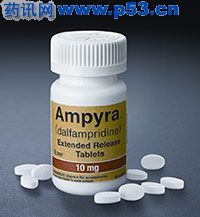制造商:
阿索尔达治疗
药理分类:
钾通道阻滞剂
活性成分(补):
Dalfampridine 10毫克;分机- REL的标签。
指示(补):
为了改善多发性硬化症(由在步行速度增加证明)患者行走。
药理作用:
在与多发性硬化症(MS),神经纤维在中枢神经系统功能降低随着时间的推移,造成除其他症状,行走困难的病人。研究表明,与微软64-85%的人走路困难,那些受影响的70%回报给他们的疾病是最具挑战性。在15的MS,1 /病人往往需要帮助行走,并在稍后阶段,高达1 / 3都不能行走2年内被诊断。
Dalfampridine,这是以前的fampridine着称,是一种广谱钾通道阻滞剂。在动物实验中,dalfampridine已被证明脱髓鞘的轴突通过增加钾通道的抑制动作电位的传导。在人类的作用机制尚未完全阐明。
dalfampridine升高的血清可导致癫痫发作。由于这种药物是由肾脏排除不变,肾功能,必须进行评估开始治疗之前,建议的剂量不应超过。
临床试验:
在改善行走dalfampridine有效性进行了评估,涉及540两例MS患者的试验。在这些患者的疾病平均持续时间为13年,平均Kurtzke扩展残疾状态量表评分为6个。
在试验1,随机,21周安慰剂对照平行组研究中,研究药物剂量在10毫克每天两次相比,安慰剂。主要疗效措施是步行速度的评估时控25英尺走,用一个应答分析。 “反应者”被定义为那些谁呈现较快步行至少3互访可能在4比在5个非双盲,没有处理访问达到了最大值双盲时期的速度。 301例患者中,283个完成了所有研究访问。试用2是一个14周的随机,安慰剂对照,平行组研究,纳入239例,227人完成了所有研究访问。在每一个试验中,服用dalfampridine患者明显有较多的反应相比,那些服用安慰剂。试验一,34.8%的患者给予dalfampridine有反应,而服用安慰剂的8.3%。试验二,鉴于42.9%的患者为研究药物反应,而安慰剂组9.3%。
一个更大比例的患者显着服用药物的研究已在步行至少10%,20%或30%的速度增长,从基线。
法律分类:
接收
成人:
燕子的整体。 ≥18yrs:10毫克每12小时。
儿童:
“18yrs:不推荐。
禁忌(补):
癫痫发作史。中度至重度肾功能损害(肌酐清除率≤50mL/min)。伴随4 -氨基吡啶的其他形式。
警告/注意事项:
轻度肾功能损害(肌酐清除率51-80mL/min)(增加发作的危险)。妊娠(Cat.C)。劳动和交付。哺乳母亲:不推荐。
不良反应(补):
泌尿道感染,失眠,头晕,头痛,胃肠不适,乏力,背痛,平衡障碍,MS复发,感觉异常,鼻咽炎,便秘,咽喉疼痛,抽筋(在高剂量可能)。
注释:
AMPYRA将分发给专门通过专业药房。欲了解更多信息,请致电(888)881-1918 AMPYRA病人支援服务。
如何提供:
制表- 60
Manufacturer:
Acorda Therapeutics
Pharmacological Class:
Potassium channel blocker
Active Ingredient(s):
Dalfampridine 10mg; ext-rel tabs.
Indication(s):
To improve walking in patients with multiple sclerosis (demonstrated by an increase in walking speed).
Pharmacology:
In patients with multiple sclerosis (MS), the functioning of nerve fibers in the central nervous system degrades over time, causing, among other symptoms, difficulties in ambulation. Research has shown that 64–85% of people with MS have difficulty walking, and 70% of those affected report it to be the most challenging aspect of their disease. Within 15 years of a diagnosis of MS, 1/2 of the patients often need help walking and, in later stages, up to 1/3 are unable to walk.
Dalfampridine, which was previously known as fampridine, is a broad spectrum potassium channel blocker. In animal studies, dalfampridine has been shown to increase conduction of action potentials in demyelinated axons through inhibition of potassium channels. The mechanism of action in humans has not been fully elucidated.
Elevated serum levels of dalfampridine can result in seizures. Because this drug is eliminated unchanged by the kidneys, renal function must be assessed before starting therapy, and the recommended dose should not be exceeded.
Clinical Trials:
The effectiveness of dalfampridine in improving ambulation was evaluated in two trials involving 540 patients with MS. The mean duration of disease in these patients was 13 years, and the mean Kurtzke Expanded Disability Status Scale score was 6.
In trial 1, a randomized, 21-week placebo-controlled parallel-group study, the study drug dosed at 10mg twice daily was compared to placebo. The primary efficacy measure was walking speed as assessed by the Timed 25-foot Walk, using a responder analysis. “Responders” were defined as those who showed faster walking speeds for at least 3 visits out of a possible 4 during the double-blind period than the maximum value achieved in the 5 non-double-blind, no-treatment visits. Of 301 patients enrolled, 283 completed all study visits. Trial 2 was a 14-week randomized, placebo-controlled, parallel-group study that enrolled 239 patients, 227 of whom completed all study visits. In each trial, a significantly greater proportion of patients taking dalfampridine were responders compared to those given placebo. In trial 1, 34.8% of patients given dalfampridine were responders, compared to 8.3% for those given placebo. In trial 2, 42.9% of patients given the study drug were responders, compared to 9.3% for placebo.
A significantly greater proportion of patients taking the study drug had increases in walking speed of at least 10%, 20% or 30% from baseline.
Legal Classification:
Rx
Adults:
Swallow whole. ≥18yrs: 10mg every 12 hours.
Children:
<18yrs: not recommended.
Contraindication(s):
History of seizures. Moderate to severe renal impairment (CrCl ≤ 50mL/min). Concomitant other forms of 4-aminopyridine.
Warnings/Precautions:
Mild renal impairment (CrCl 51–80mL/min) (increased seizure risk). Pregnancy (Cat.C). Labor & delivery. Nursing mothers: not recommended.
Adverse Reaction(s):
UTI, insomnia, dizziness, headache, GI upset, asthenia, back pain, balance disorder, MS relapse, paresthesia, nasopharyngitis, constipation, throat pain; seizures (possible at higher doses).
Notes:
AMPYRA will be distributed exclusively through specialty pharmacies. For more information, call AMPYRA Patient Support Services at (888) 881–1918.
How Supplied:
Tabs—60
Last Updated:
4/7/2010


